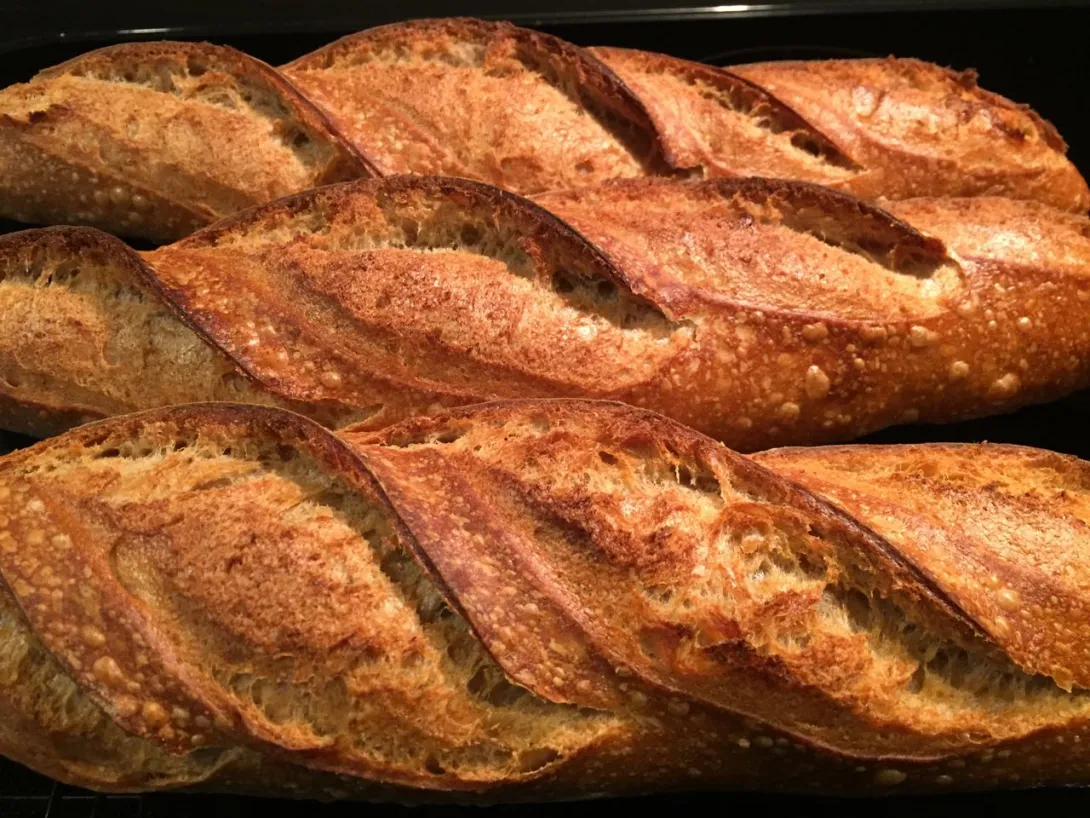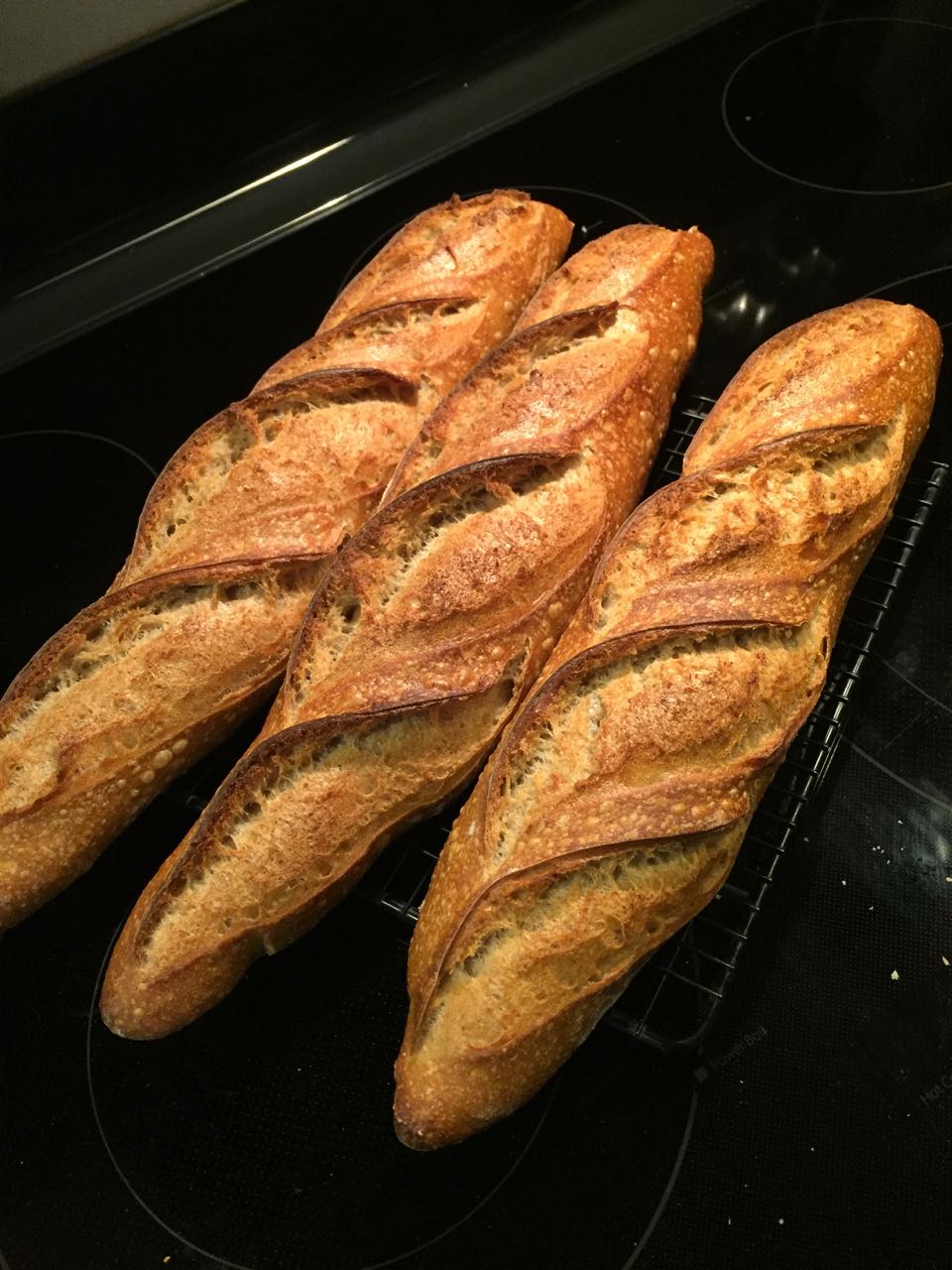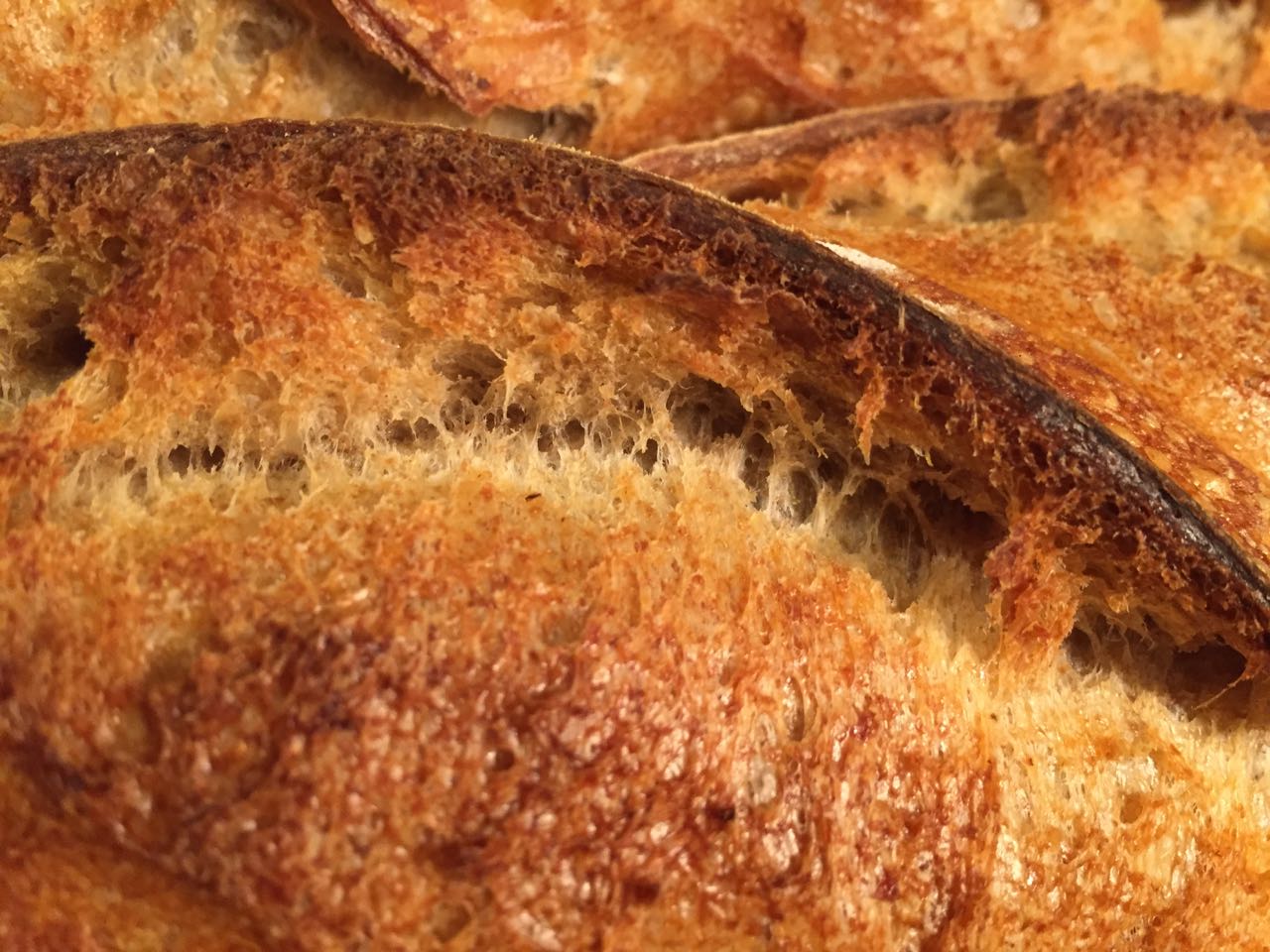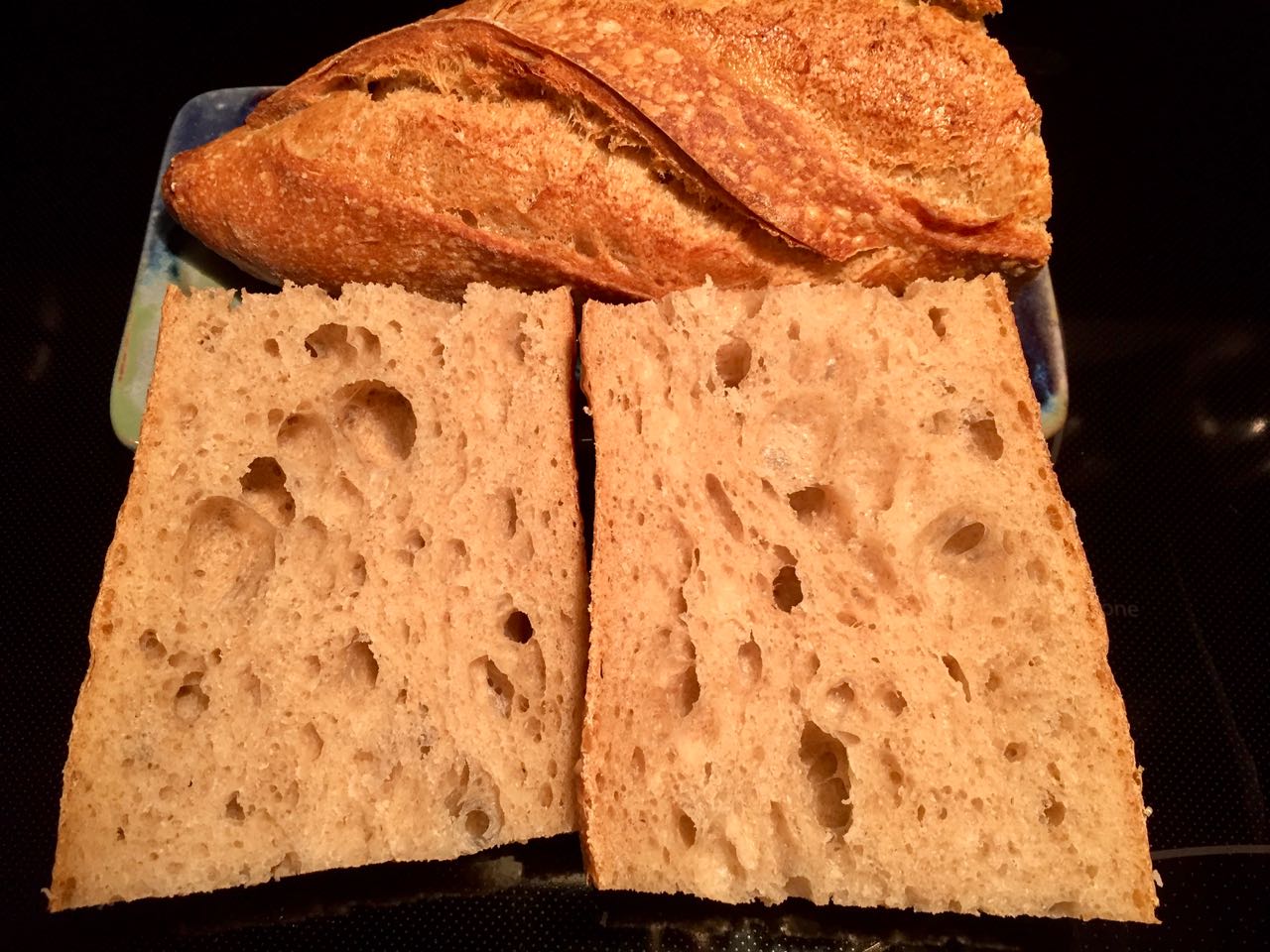
If you are new to SD baking and still having problems with high hydration and complicated doughs, don't get your knickers all in a knot. Instead drop the hydration down and get a solid footing with lower hydration breads first. Although these are baguettes, the dough can easily be adapted to batards or boules. So...
Two easy formulas that I recommend for you to get that feeling of accomplishment and dough handling skills are:
- Jeffrey Hamelman's Vermont SD at 65% hydration
- and this lovely bread, Jeffrey Hamelman Pain au Levain with WW at 68% hydration.
Make these in whatever shape you wish and feel an instant accomplishment and surety as another step to moving up the hydration ladder.
| Pain au Levain w / WW, 100% levain | |||||||||
| alfanso | |||||||||
| Total Flour | |||||||||
| Total Dough Weight (g) | 1250 | Prefermented | 15.50% | ||||||
| Total Formula | Levain | Final Dough | |||||||
| Ingredients | % | Grams | % | Grams | Ingredients | Grams | |||
| Total Flour | 100.00% | 736.2 | 100.00% | 114.1 | Final Flour | 622.1 | |||
| Bread Flour | 75.00% | 552.1 | 100.0% | 114.1 | Bread Flour | 438.0 | |||
| Whole Wheat | 20.00% | 147.2 | 0.0% | Whole Wheat | 147.2 | ||||
| Rye | 5.00% | 36.8 | 0.00% | 0.0 | Rye | 36.8 | |||
| Water | 68.00% | 500.6 | 100% | 114.1 | Water | 386.5 | |||
| Salt | 1.80% | 13.3 | Salt | 13.3 | |||||
| Starter | 3.10% | 22.8 | 20% | 22.8 | |||||
| Levain | 228.2 | ||||||||
| Totals | 169.80% | 1250.0 | 220% | 251.0 | 1250.0 | ||||
| Autolyse levain, water, flours for 30min. | 2 stage liquid levain build | ||||||||
| Add salt, mix. Then 150 French Folds, 5 min. rest, 150 FFs. | Stage 1 | ||||||||
| Bulk Ferment 2.5 hrs., Letter Folds at 40, 80 Min. | Bread Flour | 57.1 | |||||||
| Divide, Pre-Shape, 20 min. rest, Shape. Onto floured couche | Rye | 0.0 | |||||||
| Retard for 12-16 hrs. | Water | 57.1 | |||||||
| Oven to 480dF, 45-60 min. | Starter | 22.8 | |||||||
| remove from retard, onto oven peel, bake at 460dF. | Stage 2 | ||||||||
| 13 min w/steam, rotate loaves, 10-15 min. more. | Bread Flour | 57.1 | |||||||
| Vent oven for 3 min and remove to wire rack. | Rye | 0.0 | |||||||
| Water | 57.1 | ||||||||
| Total | 251.0 | ||||||||



410g x 3 baguettes/long batards
- alfanso's Blog
- Log in or register to post comments
Such beautiful bread! Those ears are stunning.
This is a can't miss formula and I'm pretty consistent with the scoring of my baguettes, regardless of the formula, with a few exceptions ;-) ...
alan
Alan, that looks like a great place to start for use beginners for baguettes. Out of curiosity, what is the finished length of the resulting baguettes with this 410 g weight each?
For those of us without a peel, could I transfer from the couche to a cookie tray with parchment and bake on that tray on a baking steel?
Benny
which is the length of my jelly roll pan and depth of the oven. 410g is a bit on the either too heavy or too light side for these. Coming in somewhere between a baguette type of bread and a batard.
I don't have a true oven peel either and also use a cookie tray. The one difference from what you outline is that I slide the parchment with dough off the peel and into the oven. You can see the whole process here.
With the exception of an IDY dough like the Bouabsa at 75% hydration my recommendation, as above ,is to start with something below 70%. Thanks to the popularity Tartine and Forkish style breads, I guess, most folks want to "master" higher hydration doughs without going through the step-at-a-time process of understanding dough handling better. To each his own, of course, and it isn't my place to say what anyone else should or shouldn't do. But I see an awful lot of posts on TFL these days with frustrated newcomers. I can only express my semi-learned opinion and leave it at that.
thanks again, alan
Extremely useful practical video Alan. I should be able to replicate something close to that with what I have, except that I might have to use the backside of my cookie tray to transfer the baguettes to the baking steel. One thing that might hinder my success at this point is the fact that my oven seems to vent when it is on, no idea how to turn that off, but I think that caused me problems with oven spring in the past when I used to bake without the dutch oven. I’m not sure that I’ll be able to overcome that, but I will try.
I have no issue with starting with lower hydration and intend to start that way. I’m still not great with high hydration with batards so don’t want to run into those issues with baguettes right off the top.
I do like that you oil your lame before scoring, I’ve never tried that but it makes sense, I’ve only recently tried dipping it into water, but oil would probably be even better.
Thanks
Benny
"and this lovely bread, Jeffrey Hamelman Pain au Levain with WW at 68% hydration."
68% has been my favorite hydration for a long time. Especially in the summer, I prefer working with lower hydration. Now with the lack of bread flour in the market, I also stick to lower hydration, typically 68%.
Very nice baguettes and your crust signature!
And at 25% whole grains, that's about in my comfort zone. My formula book was getting to be on the unwieldy side. I decided to take my favorites and place them up front for easier access. Both breads in the text are up front.
Thanks, alan
Couldn’t agree more, Alfanso.
The popularity of Tartine has convinced a lot of new bakers that high hydration is the answer. (When really it’s probably the last thing you need as a beginning baker - especially with sourdough!)
It's the "flavor" of the month, but for a decade or more now. I certainly have nothing against high hydration doughs, but they just seem to be the cat's meow with so many starry-eyed new bakers. And with the dominance of Dutch Oven baking, it seems to be one way to obtain those goals.
"Essential" to keep in any baker's arsenal as I also maintain them in mine, but the emphasis on them and getting open crumb large enough for a mouse to fall through, just isn't what early learning bakers should be aiming for.
At least that's one chipmunk's opinion.
alan
I agree that jumping headfirst into open crumb end of the pool before you can swim leads to trouble. I have found hydration to be a relative number depending on factors like the flour we use and where we live. My environment is a dry, high desert using a locally grown higher protein flour, other bakers work on the opposite end of that spectrum. Their 68% is not the same as mine. Hammelmans 2nd edition upped the water content in some of his recipes because he underestimated the abilities of bakers to handle a wetter dough. I heard him talk about the ideal hydration in the recent episode of their baking show. The goal should be to find that elusive point of the proper amount of water for the flour and the ability of the baker to work with it.
Nice bake by the way.
Alan, I’m interested in trying the baguettes at the end of this week, but I’ve never done a 2 stage levain, can you explain how this 2 stage levain build works? Are you building the stage 1, letting it mature, then once mature just adding the stage two components and then letting them mature then using 228.2 g in the autolyse. What temperature are you fermenting the starter at and approximately how long are you starting the starter prior to autolyse?
Benny
differing ways, of course. And what you wrote is exactly how it is intended as written, although not what i actually do.
There are also a number of folks who opt for a 3 stage set of builds, and I think that it is more of a professional baker thing to do. And when they do, I believe that they have a different method, going from really small first and second builds to a really big third build. Chad Roberston and Ken Forkish to name just two.
I'm merely providing a simple scenario for the two stage here.
Now, I'm fairly unconventional. I keep a vat of a few hundred grams of AP levain in the refrigerator - you may recall my recent post about not having refreshed it for a number of weeks and scooping directly out of that. When I feel as though I want to or need to refresh (not do builds) I'l just scale some round number amount and then do a 1:1:1 or 1 : 1.5 : 1.5 or 1:2:2 . I'm not picky as I just want enough goop to have sufficient amount for a next dough, whether that day or another. I could never get away with this scheme in a real world bakery environment. I'd be run out of town on a rail.
The anagram for my name is anal, but when it comes to levains and builds I'm anything but (or butt)! My 100% AP levain seems to look after itself pretty well, wanting little from me except the occasional TLC.
Thank you, and yes I remember now that you’re a bit unconventional, but we all figure out eventually what works for each of us.
Benny
Alan, at what temperature do you bulk ferment at? Also what increase in volume are you aiming for during bulk fermentation.
I was planning on doing the first build of the levain in the evening, placing it in the fridge and then doing the 2nd build of the levain the next morning. I’m hoping to have a go at this starting tomorrow evening.
I’m going to make each Demi-baguette 300 g to better fit on my baking steel.
Wish me luck.
Benny
I don't pay attention to the DDT after mixing. My apartment is a relatively constant 78dF give or take 2 degrees. As I mix by hand, I don't consider the temperature rise that mixing friction creates. The dough rests on my countertop between every French Fold and during the 5 minute rest between sets of folds, so the counter itself is also a contributor to the ambient temperature.
I pay no attention to the rise in the dough. In complete opposition to the vast majority on TFL, I watch the clock, not the dough (gasp). I couldn't even tell you how much it rises, but when I do countertop letter folds the tactile feel of the dough informs me of how it has been progressing.
If a formula calls for i.e. a 3 hr rise, and it comes from chilly Vermont, I give it 2.5, let's say. If it comes from Albuquerque New Mexico, I give it a few more minutes. If a formula calls for adding the levain after the autolyse, and I add it along with the autolyse, which I now do almost all the time, I give it a shorter autolyse.
I don't temp the dough at any stage and I don't temp the bread when it looks ready to emerge from the oven.
I take the dough out of retard less than 5 minutes before I score it and place it in the oven. I only follow the "rules" as far as the amounts of ingredients go, and then not always. For example, I know that high hydration doughs do not do well in my hands when forming baguettes (Bouabsa exclude, for one), so I'll lower the hydration. a few clicks.
Well, I hope that clarifies things for you ;-) .
Actually it does help to know your room temperature, it is what I will do BF at then. Thank you Alan.
Benny
Hi Alfanso,
May I ask why you don't include any rye in your levain (6.5% of rye in the book)?
Also, what would the timing to build the 2 stages levain? Would stage 1 in the morning and stage 2 in the evening work?
Thanks :-)
Gaelle
is that we are free to roam far afield from the original without necessarily losing sight of it. It always helps when starting out with the original author's intent, and then taking flight from there.
Mr. Hamelman often works with 125% hydration levains, both rye and white flour, and in this case 60%. And for a time, and just for the fun of it, I used to keep one of each 125 bubbling away in the netherworld section far back in my refrigerator. But I eventually decided to stop, and also to convert his 125% levains to 100% levains in some formulae. I'm certain he has taken no offense! One of the curiosities for me is that when he changes the levain hydration or flour type he doesn't explain why. Why is a 60% rye levain used here rather and a 100% AP flour levain? There has to be some explanation of his decision but it is not part of his writings, as far as I can see.
I've kept the overall total dough percentages as was written by Mr. Hamelman, just re-arranged some of the "furniture" within the formula and the methodology.
Timings on builds are dependent on the activity of the levain starter, the type of flour and the ambient temperature. Generally I find at Chez Alfanso with a steady ambient temperature of 78-80dF that each of the first two builds with a white/AP flour at 100% hydration takes 6-8 hours.
But of course you can do a single stage build rather than two or three. All part of the free to roam. You can do that in almost all cases where there isn't a specific reason for multiple stages - like the Detmolder technique. A three stage will generally yield a more robust final levain, but I haven't found running a single stage build to be detrimental at all. I'm doing that right now. And most times that is what I do, a mere single stage. I'm much more aligned with controlling time and temperature, hence scheduling to fit my personal desires, than to being a strict adherent to the author's formula and methodology.
If you wish to stick with his 60% hydration levain and steps, by all means, do so. If using my formula above, then just calculate down the levain from whatever starter you currently nourish and then adjust the remainder of the formula - or much easier - just follow his version in the book!
And as I've mentioned on TFL many times, find a formula you like, and then change one or more things about it to suit your interests/tastes/curiosity and call it your own.
Good luck, have fun and expect some frustration at shaping and scoring. But don't get bummed out if doesn't turn out Instagram perfect. It's all part of the learning process to get to where you eventually want to be. And remember - even ugly bread can be delicious.
alan
Thank you so much for your time and your patience in explaining to me all of this!! I totally get the gist but am not experienced enough for the moment to take any liberties with any recipe or formula...That's why I prefer to follow more experienced bakers' steps like yours! I was also wondering why the levain would be different from one recipe to another in Hamelman's book, but thought that it was too obvious to be spelled out... but apparently not!
I just built the 1st stage of the levain as described in your formula and am going to stick to your methodology for the whole process...Also intending to shape those babies into lovely imperfect baguettes...it's going to be SO-MUCH-FUN !!! :-)))
And believe me, I'm a real master in the art of baking ugly breads, and proud to be..... I can't have enough of them!!
Local Breads – Daniel Leader, page 43.
Liquid levain. This is a relatively new kind of sourdough, a batterlike culture made from wheat flour and water that is easy to mix and easy to measure out. It has gained in popularity in France because it ferments more easily and is easier to mix and measure out than stiff dough levain. Liquid levain has a fruity taste and a light, bubbly feel all over your tongue. It is mildly and immediately sour.
Stiff/dough levain. This very firm sourdough is the traditional French bread starter. It ferments very slowly, a plus for French bakers who abhor overly sour bread and want to limit the production of acids in their sourdough. In contrast to liquid levain, stiff dough levain is mild but earthy and not as light on your tongue. Its flavor is richer and darker and develops slowly in your mouth.
Cheers,
Gavin
Fantastic thread, thank you Alfanso, and couldn't be more timely. I was just going through Hamelman again. I had yet another 79% Rubaud Pain Au Levain Soup (see below, just after mixing. Nothing helped - no improvement through the ferment though I deviated from his method to include many coils, etc., during the bulk), so I finally dropped the ego and decided to pull his formula back to 72% hydration, to go with 30% levain (baker's - pre-ferment flour is 15.8%) as opposed to his 40, following Jeffrey Hamelman and many others.
I am not quite to two, but do intend on 3 - Hamelman's Vermont at 65%, Rubaud's pain au levain (not as changed with 13% whole grain, but keeping the 30% whole grain) at 72%, and this excellent rye levain by Wooden Spoon. My wife demands rye, her Baltic blood, and I am learning to really love working with it.
But I place 90% of my stock in two very close to your suggestions, Vermont Sourdough and Rubaud Pain Au Levain.
Your pictures are stunning and a great inspiration. I think this thread alone could be a benchmark to work from. Thanks for creating it.
Oh - can you or someone clarify what you mean by "French Folds," specifically? Are these the kind of radial-to-the-center-folds, say, 6-8 "spokes"?
Richard Bertinet has a video out there on French Folds which folks seem to reference. It is a good technique for developing gluten, but has it's limitations in that you really can't get away with it for anything more than maybe 2-3kg of dough, just too much dough to handle easily. I try to mix mostly everything by hand and this is what I do, and how I do it, and a picture (or two) might be worth a thousand words.
This was done in my early days and I've long since tamped down the number of French Folds to mostly limit them to 2 sets of ~40-50 with a 5 minute rest between. This dough is all AP flour at 75% hydration, hence the amount of "sloppiness" to its initial structure.
It is not necessarily better than other ways of mixing, just the way I enjoy mixing the dough and with few exceptions, do FFs all the time. Might not be your cup of tea, especially if you are dealing with more than, say, 3x this much dough.
I'm one who has the habit of swimming agains the tide and tend to keep my distance, for both good and bad, from the popular or trendy. And so I was reluctant to try a Hamelman formula, but eventually knuckled under and I'm so glad that I did.
Likely this type of rye will just not satisfy your wife's "needs", but a few months ago we had a CB on Deli Rye breads.
Alan
OK great, thanks for the clarification, Alan. I wondered if that might be the Bertinet method, just wasn't sure that was what it was commonly called. As I have learned them (and I put a caveat on that), I tend to prefer Rubaud mixing but also really enjoy the Bertinet technique. Kind of miraculous to me something so raggedy can come together so beautifully with such a simple set of moves. I may be screwing it up, too, but it seems I get better strength from the Bertinet method than the Rubaud, on higher hydrations. Of course, your thread hit home and I'm heading back to lower hydrations. Excellent and helpful, thanks again.
The CB deli bread bake...wasn't aware, thanks, as I enjoy these breads a lot. These Nordic pagans demand their rye breads dark, dense and sour (I've learned to like them too)! Working up the stones to do Hammelman's vollkornbrot (I like his Detmolders).